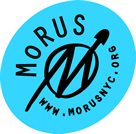by John C. Harris
June 1 2021
The Museum of Reclaimed Urban Space.
Is the name a mouthful? Possibly. But its acronym MoRUS offers a friendlier nuance. And can those of us who volunteer here consider MoRUS a friend, or better yet, an accomplice? Over the past year, the Museum offered space for volunteers to come together and commit to positive change and grassroots organizing, so it sure seems like a yes. These efforts have taken shape in the form of a revitalized MoRUS ready to embrace its mission to preserve and promote the history of activism within the Lower East Side, with fresh zeal and new direction. But first, before we return to this new MoRUS, let us take a moment to consider that name. In its entirety. Dissected. Then put it back together again, much like the process undertaken in 2020.

(Image of NYPD facing off with housing advocates during a squat eviction, photo by John Penley)
The Museum. There are no museums like this — situated within the storefront of C-Squat, a squat turned housing co-op, at 155 Avenue C, MoRUS is the manifestation of the very story it tells. It is the kind of cultural hub where on any given day a local activist might visit to prepare for their next demonstration, an artist may drop off additions to the zine library, and a squatter or housing advocate might venture in to tell of their underground affairs. The history which the Museum tells is unfolding to this very day, and many of the historical actors are still alive. This complicates the work but makes it all the more necessary as MoRUS is critical to sharing accurate accounts of the neighborhood’s history which in turn allows a thoughtful maneuvering of the community’s present and a positive direction regarding the future of the neighborhood. Likewise, it provides insight for communities throughout the country and around the world that may look to the Lower East Side as an example of how the role of activism, in its many forms, can shape their existence.

(Image of the interior of MoRUS, photo by Bill Di Pola)
Reclaimed. This concept is the most contentious and most critical to the story we tell. What does it mean to reclaim space on the occupied land of the Lenape, the indigenous inhabitants of what we know as Manhattan before the arrival of colonial powers? We must consider that question openly and the Lenape’s past must be acknowledged. Therefore, it is our responsibility to assert that before anyone else, the land on which this museum stands, and all other space we posit within the scope of our mission, is that of the indigenous communities that lived here first. Their experience of displacement, exploitation, and abandonment by colonial powers are key to the formation of the era we are focused on: the twentieth century and beyond. And it was that same notion of abandonment by the city of New York that prompted the community members of the Lower East Side to reclaim stewardship over the resources that they had the skills to control in order to fulfill the needs of a neighborhood which by the 1970s was seemingly forgotten by its government. That is until those same community members transformed the Lower East Side into a profitable commodity ready to be co-opted by corporate interests just before the turn of the century, and since then the struggle of ownership between community, business, and government has been core to the retransformation of the neighborhood.

(Image of James Hong’s Plywood Windows of SoHo: Black Lives Matter exhibit from fall 2020, photo by Bill Di Pola)
Urban. A word rooted in Latin that designates a relation to a city. But the conceptualization of just what a city is and how the urban reveals itself are entirely subjective. The Lower East Side is one of the most populated neighborhoods in Manhattan. Large enough to be considered a city within a city, its diverse population has led to many different understandings of community and belonging. The stories that MoRUS seeks to tell reveal the vanguard of alternative urban design rooted in the struggles and direct action that culminated out of the Lower East Side.
Space. The spaces within our scope are as diverse as the stories and experiences we aim to preserve and promote. These spaces range from the neglected buildings and their then tenants, as well as the newly arrived mid-20th century homesteaders turned squatters who took it upon themselves to rebuild and remodel some of the tenements, eventually buying them back from the city as co-ops. Our focus also includes the abandoned lots of a nearly bankrupt New York City in the 1970s transformed into community gardens. As well as community designated recycling sites implemented in the 1990s. And more recently the freshly painted and still emerging system of bike lanes of the 21st century to promote a more sustainable mode of transportation and a healthier community. Each kind of space, and many more unnamed here, play a vital role in an evolving understanding of how to reclaim and understand the material and cultural infrastructure of urban spaces.

(Image of a RTS rally to promote sustainable urban design, photographer unknown)
Our freshly reinvigorated MoRUS will continue to merge each of these concepts in our quest to explore the history of the Lower East Side. Our exhibits highlight examples of direct action over the decades. Our zine library is ready to be explored. Part of our efforts have also included revamping the archive and the collections of historical records, documents, and ephemera are more processed and accessible than ever. They are ready to be explored by our visitors and researchers alike and we hope to make them available on the website through Collective Access soon! In the meantime, we urge you to come by to explore these resources and have your understanding of the neighborhood challenged and to leave more well informed!

